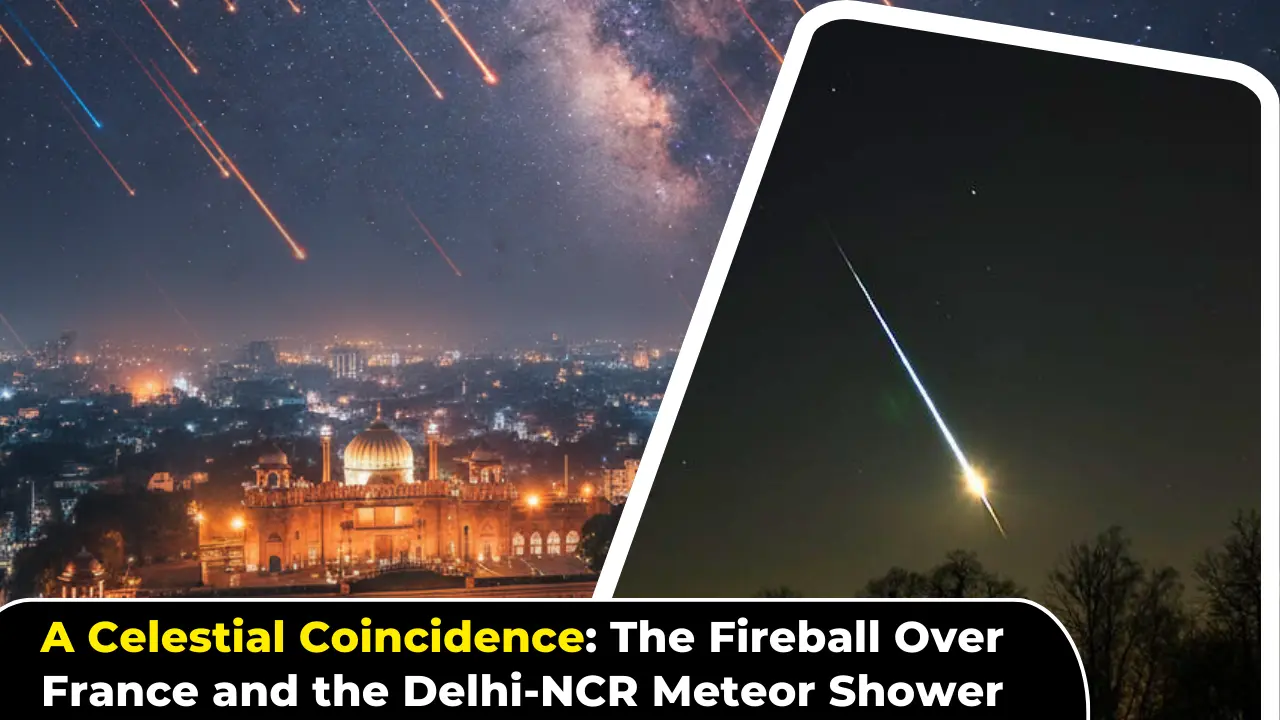The Fireball Over France: On a chilly night, an eerie glow lights up the sky over Normandy, France. Just days later, a similar spectacle streaks across the heavens above Delhi and the National Capital Region (NCR). What is happening in the sky? While these two events might seem connected, they are, in fact, distinct celestial phenomena that offer a glimpse into the dynamic nature of our solar system.
This blog post delves into the science behind these awe-inspiring events, from a rare asteroid explosion to a mesmerizing meteor shower.
The Fireball Over France: A Rare Asteroid Explosion
The first event, a fiery spectacle over France, was no ordinary “shooting star.” It was a small asteroid, designated 2023 CX1, that entered Earth’s atmosphere on February 13, 2023. Unlike most meteors that gradually burn up, this one behaved in a shocking and unusual way. Astronomers had a brief but critical window of about seven hours to track its trajectory before it hit. This was a significant achievement in planetary defense.
So what made this event so different?
- Sudden Catastrophic Breakup: Instead of slowly ablating, or shedding pieces, as it descended, 2023 CX1 stayed mostly intact until a remarkably low altitude of about 28 kilometers. It then exploded in a single, powerful burst, releasing an estimated 29 tons of TNT equivalent in a fraction of a second. This “airburst” created a strong, spherical shockwave, a behavior rarely seen in such small objects.
- A Scientific Goldmine: The precise tracking and the unique nature of its disintegration made this a landmark event for planetary defense. The fragments, later recovered in Normandy, were identified as L-type chondrites, a common type of stony meteorite. However, the way the object broke apart has given scientists new insights into the material strength of certain asteroids, which could help in developing more accurate models for predicting the threat posed by similar objects. It was a real-world, high-stakes experiment that validated new observational strategies.
The Meteor Shower Over Delhi-NCR: Space Debris or Celestial Rock?
Just as the global community was still buzzing about the French fireball, another dramatic light show unfolded over Delhi and the surrounding NCR. On the night of September 20, 2025, residents witnessed bright, fiery streaks that lit up the urban sky, sparking a frenzy of social media posts and speculation. But was this a true meteor shower?
While initial reports and some eyewitnesses likened the event to a meteor shower, scientific analysis suggests a different explanation. Many sources, including analyses on platforms like X (formerly Twitter), pointed to the event being a case of re-entering space debris.
Also Read: Delhi-NCR Celestial Mystery: Meteor Shower or Space Debris?
The slow speed and the distinct fragmentation pattern of the object are more consistent with a human-made object breaking up than a natural meteor.
Here’s why this distinction is crucial:
- Meteors vs. Space Debris: A meteor is the streak of light we see when a natural rock from space (a meteoroid) enters our atmosphere. A meteor shower occurs when Earth passes through a trail of debris left by a comet or asteroid. In contrast, space debris is old, defunct human-made hardware—like rocket stages or satellites—that re-enters the atmosphere and burns up.
- The Science of the Sighting: The Delhi-NCR event was reportedly visible over a wide area, but its characteristics were more aligned with a piece of space junk. The object was likely part of a Chinese Long March 3B rocket stage re-entering the atmosphere. This type of event, while also spectacular, is a reminder of the growing problem of space pollution.
What’s Happening in Our Skies and Why It Matters
The coincidental timing of a fireball over France and the meteor shower in Delhi-NCR has captivated the world’s attention, but they serve as two different, compelling reminders of what lurks above us. The French event highlights the incredible progress in planetary defense, where scientists can now track and predict the fall of even small asteroids with remarkable accuracy. This is a critical step in protecting our planet from potential future impacts.
On the other hand, the Delhi-NCR sighting brings the issue of space debris into sharp focus. With thousands of satellites and rocket bodies orbiting Earth, the risk of a re-entry event over a populated area is increasing. This calls for greater international cooperation on space traffic management and responsible de-orbiting of space assets.
How to Tell the Difference and Be a Skywatcher
So, the next time you see a streak of light in the night sky, how can you know what you’re looking at?
- Speed: Meteors typically move much faster across the sky than re-entering space debris.
- Fragmentation: Both can fragment, but space junk often breaks into many glowing pieces that follow a more predictable path.
- Time of Year: Check for scheduled meteor showers. While spectacular fireballs can occur at any time, a known meteor shower is a good clue. For instance, the Perseids are active in August, while the Geminids peak in December.
The sky is a dynamic and fascinating place. While the fireball over France and the Delhi-NCR meteor shower were not connected, they both highlight the importance of looking up and understanding our place in the cosmos.

















